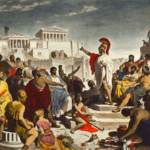They use terms like “TEOTWAWKI,” have “bug out bags” meticulously packed, and stock their pantries with buckets of emergency foods which boast shelf lives of 25 years.
These individuals are called “preppers,” and they pride themselves on planning for everything from natural to EMP disasters. Today, the prepper movement is growing quickly in the US, but when and how did this movement get started?
Recommended Reading
The History of Christmas
The Great Irish Potato Famine
Boil, Bubble, Toil, and Trouble: The Salem Witch Trials
Origins of the Prepper Movement
Many prepper websites are quick to remind us that preparedness used to be a normal activity. They give examples of how older generations canned their own vegetables and knew how to hunt.
However, these early people prepared more out of necessity than personal philosophy. Thus, for these early groups, preparedness was simply a part of everyday life. It wasn’t until conveniences like supermarkets and mass-produced goods were ubiquitous that the prepper movement could get started. In other words, society needed to be unprepared for a preparedness movement to take place.
The first chapter of the prepper movement takes place in the 1950s, when the Cold War created mass paranoia
1950s and 1960s: Cold War Paranoia and Recession

In the US, during the 1950s, the Cold War with Russia (at the time the USSR) was going strong, and many Americans believed a nuclear bomb could drop at any movement. The US government encouraged citizens to build fallout shelters, and bomb drills were part of most people’s daily lives.
On top of this, a series of recessions hit, and one investment advisor, Harry Browne, started giving seminars on how to survive monetary collapse.
The sense of fear which characterized these decades can be seen in Don Stephen’s 1967 book, Retreater’s Bibliography, in which he encouraged people to build a survival retreat in a remote location. He coined the term “retreater,” and he outlined tactics such as recycling materials and using renewable energy. These are the same tactics often discussed by contemporary preppers. (1)
1970s and 1980s: Retreaters and Survivalists
In 1975, author Kurt Saxon began writing a newsletter called The Survivor. In this publication, he talked about pioneer skills and early technologies. He is often credited for coining the term “survivalist.”
In the 1970s, the terms “survivalist” and “retreater” were often used interchangeably. However, they soon began to differentiate, and survivalist became associated with a more combative style of preparedness. Later, Saxon wrote controversial books on how to make homemade weapons such as bombs.
By contrast, a retreater was someone who tried to avoid conflict and become invisible.
Numerous other books about economic collapse and disaster preparedness were published during this decade, and by the 1980s, survivalism had become a multibillion dollar industry. In addition to books, there were expos for survivalist equipment starting in the 1980s. (2, 3, 4)
1990s: Radicals and Extremists
In the 1960s, the survivalist movement was linked to the burgeoning ecology and sustainability movements. (1)
However, by the 1990s, these movements had split. Survivalists were considered to be very right-wing conservatives with radical anti-government sentiments. (5) These negative connotations were only reinforced by a series of events linked to survivalist groups, such as the siege on Ruby Ridge in 1992, the siege on the Waco compound in 1993, and the terrorist attack by Timothy McVeigh in 1995.
The Y2k scare slightly revived the survivalist movement. However, when the scare turned out to be bunk, it only reinforced the idea that survivalist ideology was extreme and unfounded. (6)
2001: First Use of the Term Prepper
According to the Merriam-Webster dictionary, the first known use of the term prepper was in 1904. However, there is no evidence of where it was used. In fact, a date-specific Google search for “prepper” for the year 2000 shows no results which contain the term.
By 2001, though, things started to change. A Google search for this year shows several prepper websites had popped up by the start of the year.
Then the terrorist attack on September 11th took Americans by surprise. Suddenly, authorities were instructing people to stockpile duct tape, make disaster kits, and be ready to evacuate. These were things that survivalists had been preaching for years. Their fears had been suddenly confirmed, and survivalist warnings were now being echoed by authorities. (7)
The need to prepare was once again reinforced by events like Hurricane Katrina and the Great Recession. Over the first decade of the 21st century, preparedness went from being something associated with extremism to a patriotic duty. By 2010, polls showed that 50 percent of Americans were thinking about preparedness – an increase from 18 percent in 2004. (8)
2010 and Onward: Preppers Go Mainstream

Around 2010, the prepper movement made an active push to distinguish themselves from the survivalists of the past.
In a 2010 article on BBC, Tom Martin, founder of the American Preppers Network, says that survivalists are people with a history of guns and ready-to-eat meals who can live off of the land. By contrast, prepper is a more generalized term. Preppers don’t try to isolate themselves in preparation for Armageddon. Instead, they keep normal lives and have a relaxed view about pending disasters.
Another article during from 2010 entitled “Rise of the Preppers: Survivalists Get a Makeover” makes it clear that preppers aren’t “just another group of paranoid doomsdayers.” They mostly focus on natural disasters while mixing in some traditional views of self-reliance. A Newsweek article from 2010 called the prepper movement “Survivalism Lite.”
In the following years, the prepping movement experienced a huge boom. Google Trends shows a massive increase in the search term “prepper” in March 2012, which coincides with the National Geographic TV show, Doomsday Preppers. Even though the TV show mostly depicted more extreme versions of prepper culture, the movement still pushed a more rational, calm approach to prepping.
For example, in addition to selling ammunitions, a prepper expo during that period offered classes in emergency suturing, and it also sold items such as solar ovens and organic energy drinks. (7)
Latest Society Articles
Who Invented Democracy? The True History Behind Democracy
Medieval Fashion: Tunics, Underclothes, Pointed Shoes, and More!
37 Underground Cities: The Hidden Pillars of Civilization
As cultural anthropologist Chad Huddleston notes in a Washington Post article on the movement, the term “prepper” was originally one with which people wanted to avoid being connected. But, as the decade wore on, more people became comfortable with being called a “prepper.”
Prepper Demographics
There is very little information about how many preppers are out there. This is possibly because many prepper websites encourage preppers to keep their activities secret so that no one will steal their supplies when disaster strikes.
Despite the limited demographic research, it is clear that preppers are a big market. One poll of 2,000 Americans found that 65 percent owned or had recently purchased survival gear. Of these, 36 percent of them had spent up to $400 on survival kits in the previous 12 months.
Another study by Global Biodefense estimates that between 4 and 9 million Americans are actively engaged in prepping. These preppers are not extremists but rather “ordinary” people who want to prepare their families for emergency events. The study also found that 50 percent of preppers spend more than $500 per year on supplies, with between 15-30 percent spending more than $1,000 annually.
Traffic to prepper websites and communities has also exploded. A quick YouTube search shows that many prepper channels have more than 40,000 subscribers. Some channels even have over 400,000 subscribers.
On Facebook, there are numerous prepper groups with over 60,000 members. Some popular prepper pages on Facebook have over 100,000 followers.
Most information shows that typical preppers are middle-class, white, conservative men. However, more women are becoming interested in the prepper movement. There is also a smaller trend of “liberal preppers.” (9, 10, 11, 12)
Common Practices among Preppers
On prepper websites and communities, there are many common themes about which steps need to be taken to get prepared for disasters. The main ones include:
- Stockpiling food and water
- Packing a “bug out bag” in case of evacuation into the wilderness
- Planning for a blackout or grid outage
- Adapting off-grid technology
- Learning wilderness skills (bushcraft)
- Practicing first aid
- Learning self-defense
- Food production
- Making an evacuation plan
Personal Philosophy of the Preppers
Preppers will often talk about self-reliance, self-sufficiency, and how it is a citizen’s duty to take care of themselves (as opposed to relying on the government to help in times of disaster).
As the Centre for the Critical Study of Apocalyptic and Millenarian Movements (CenSAMM) points out, these prepper philosophies are linked to traditional ideals upon which America was founded.
Preppers will often romanticize the lives of previous generations as being more autonomous. For example, it is common to find articles on prepper websites which tout skills early pioneers had. However, these are imaginative accounts of pioneer life and are not based in evidence.
Yet despite this lack of evidence, preppers will still preach about “going back to roots” and learning traditional skills so as to achieve greater autonomy.
Links to Other Movements
The prepper movement and its focus on self-sufficiency is linked to many other contemporary movements.
For example, preppers often advocate for a DIY approach, which actually has its roots in the punk movement of the 1970s. Preppers are also advocates of self-sustainability practices such as rainwater harvesting and alternative energy. These are views shared with the environmental movement. (13)
You’ll also see lots of talk about home gardening and home canning on prepper sites, both of which are popular with Millennials. (14, 15)
Explore More Society Articles
History of Valentine’s Day: The Dark Origins of Valentine’s Day and Why We Celebrate It
The History of Asbestos
The History of RVs
Counter-Factual History: Valid Exploration or Inappropriate Time Waster?
Who Invented Democracy? The True History Behind Democracy
Six of the Most (In)Famous Cult Leaders
The prepper movement rarely gets linked to these other movements, though. The reason is likely due to the fact that preppers are largely seen as right wing and conservative. By contrast, these other movements are often on the left politically and liberal in their views of gun ownership and immigration. (16)
Conclusion
Overall, the prepper movement has a rich history. It traces its roots back to the pioneers of the 19th century, but it really took off during the Cold War. Now, it seems prepping is something most people do, and as the world enters a period of rapid change and excessive uncertainty, we can expect that more and more people will become preppers, adding another chapter to the movement’s history.
Works Cited:
- King, Lynda. Preppers: History and the Cultural Phenomenon. Prepper Press, 2014
- https://www.theguardian.com/technology/1999/feb/03/freespeech.internet1
- https://www.theguardian.com/technology/1999/feb/03/freespeech.internet1
- https://ipfs.io/ipfs/QmXoypizjW3WknFiJnKLwHCnL72vedxjQkDDP1mXWo6uco/wiki/Survivalism.html
- https://censamm.org/resources/profiles/survivalists-and-preppers
- https://motherboard.vice.com/en_us/article/bmvy8d/canned-food-doomsday-fears-and-the-y2k-hoarding-disaster-that-didnt-happen
- https://www.nytimes.com/2012/11/18/magazine/how-to-survive-societal-collapse-in-suburbia.html
- https://www.newsweek.com/rise-preppers-americas-new-survivalists-75537
- https://www.bloomberg.com/news/features/2017-11-22/business-is-booming-for-america-s-survival-food-king
- https://qz.com/973095/the-new-doomsayers-taking-up-arms-and-preparing-for-catastrophe-american-liberals/
- https://www.businessinsider.com/inside-doomsday-prepper-community-photos-2017-2
- https://www.outsideonline.com/1922686/boom-times
- https://www.permanentculturenow.com/introduction-to-diy-counterculture/
- https://www.maximumyield.com/how-and-why-millennials-are-making-hydroponics-mainstream/2/3653
- https://www.prnewswire.com/news-releases/united-states-of-diy-nearly-half-of-all-millennials-are-interested-in-canning-this-summer-300116284.html
- https://www.studentnewsdaily.com/conservative-vs-liberal-beliefs/











Preppers will often talk about self-reliance, self-sufficiency, and how it is a citizen’s duty to take care of themselves (as opposed to relying on the government to help). I think that talking is about as far is this kind of “self-sufficiency” goes.